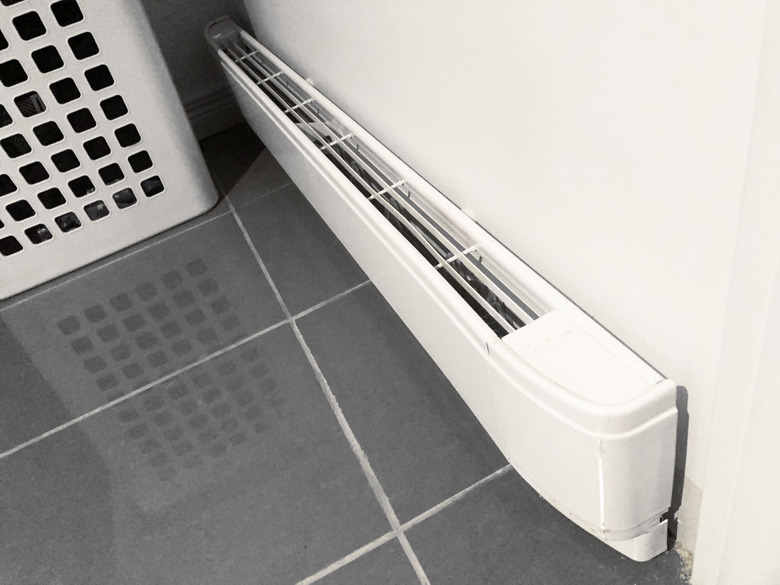How To Connect Your Honeywell CT410A Thermostat
We may receive a commission on purchases made from links.
The Honeywell CT410A and CT410B are line-voltage thermostats typically used to control an electric baseboard heater, and as such, they operate much like wall switches. Instead of an on/off toggle, this type of thermostat has an adjustable dial that allows the user to program the switch to open and close according to preset temperature limits. You don't need to know the details about how a line-voltage thermostat operates to wire it properly, but you do need to understand that unlike wiring a low-voltage thermostat, wiring a line-voltage thermostat is dangerous, and you can get a serious and even fatal shock if you don't turn off the power before you start.
The Honeywell CT410A can control both 120- and 240-volt heaters, and it's wired directly to the home's electrical panel rather than being wired through a transformer like most central air system thermostats. Because it's basically a switch, it has only hot terminals, and neutral circuit wires bypass it and get spliced together. As with any other switch, the ground wires must be connected to the ground terminal on the thermostat.
How to Connect a Honeywell CT410A Thermostat
How to Connect a Honeywell CT410A Thermostat
Before you start wiring your thermostat, it's important to know whether the heater it will control runs at 120 or 240 volts. If the former, you'll need 12/2 cable, which is 12-gauge cable with a hot, neutral, and ground wire, and if the latter, you'll need 10/3 cable, which is 10-gauge cable with two hot wires (red and black), a neutral wire (white), and a ground. Since a 240-volt baseboard heater doesn't have any auxiliary equipment that requires 120-volt power, you can also use 10/2 cable, which has a white, black, and bare ground wire, to power it.
1. Run the Cable to the Thermostat Location
Run one length of cable from the service panel to the thermostat and another length from the heater to the thermostat. You can connect the cables to the heater and to a circuit breaker in the panel after wiring the thermostat. If you're replacing an existing thermostat, the wires will already be in place, so be sure to turn off the circuit breaker before removing the old thermostat and wiring the new one.
2. Make Sure There's an Electrical Box
If you're replacing an existing thermostat, the electrical box will probably already be installed, but if not or if you're installing a new thermostat, you need to install one. Don't just leave wires hanging freely from the drywall. The easiest way to meet this important electrical requirement is to install an old-work (remodeling) box, which attaches to the surface of the drywall.
3. Check the Terminals on the Back of the Thermostat Plate
The Honeywell CT410 series thermostat has four terminal connections: two for hot wires coming from the panel, which are marked L1 and L2, and two for hot wires going to the heater, marked T1 and T2. If you're connecting a 120-volt heater, you only need the L1 and T1 terminals and can ignore the other two, but you need all four if you're wiring a 240-volt heater.
4. Connect the Hot Wires to the Thermostat Plate
Connect the black wire coming from the panel to the L1 terminal and the black wire going to the heater to the L2 terminal. If you're wiring a 240-volt heater, connect the red wire from the panel to the L2 terminal and the red wire going to the heater to the T2 terminal. If you're using 10/2 cable, connect the black and white wires to the terminals.
5. Connect the Ground Wires
Connect both ground wires to the ground terminal. The easiest way to do this is to twist the ground wires together, leaving one end longer than the other, and connect the long end to the terminal screw. You can also crimp the ground wires together with a crimp sleeve and connect one of them to the terminal.
6. Splice the Neutral Wires Together
If you're wiring a 120-volt heater with 12/2 cable or a 240-volt heater with 10/3 cable, you'll have two spare white wires in the electrical box. Twist these together and screw on a wire cap. If you're wiring a 240-volt heater with 10/2 cable, there won't be an extra neutral wire, so you can skip this step.
7. Mount the Thermostat
Push the wires into the electrical box and mount the thermostat plate on the wall using the fasteners supplied with it. Use a torpedo level to level the plate before you fasten it, as the thermostat won't work properly if it's out of level. Once the plate is secure, snap on the thermostat face plate and connect the wires to the heater and then to the circuit breaker in the panel.
